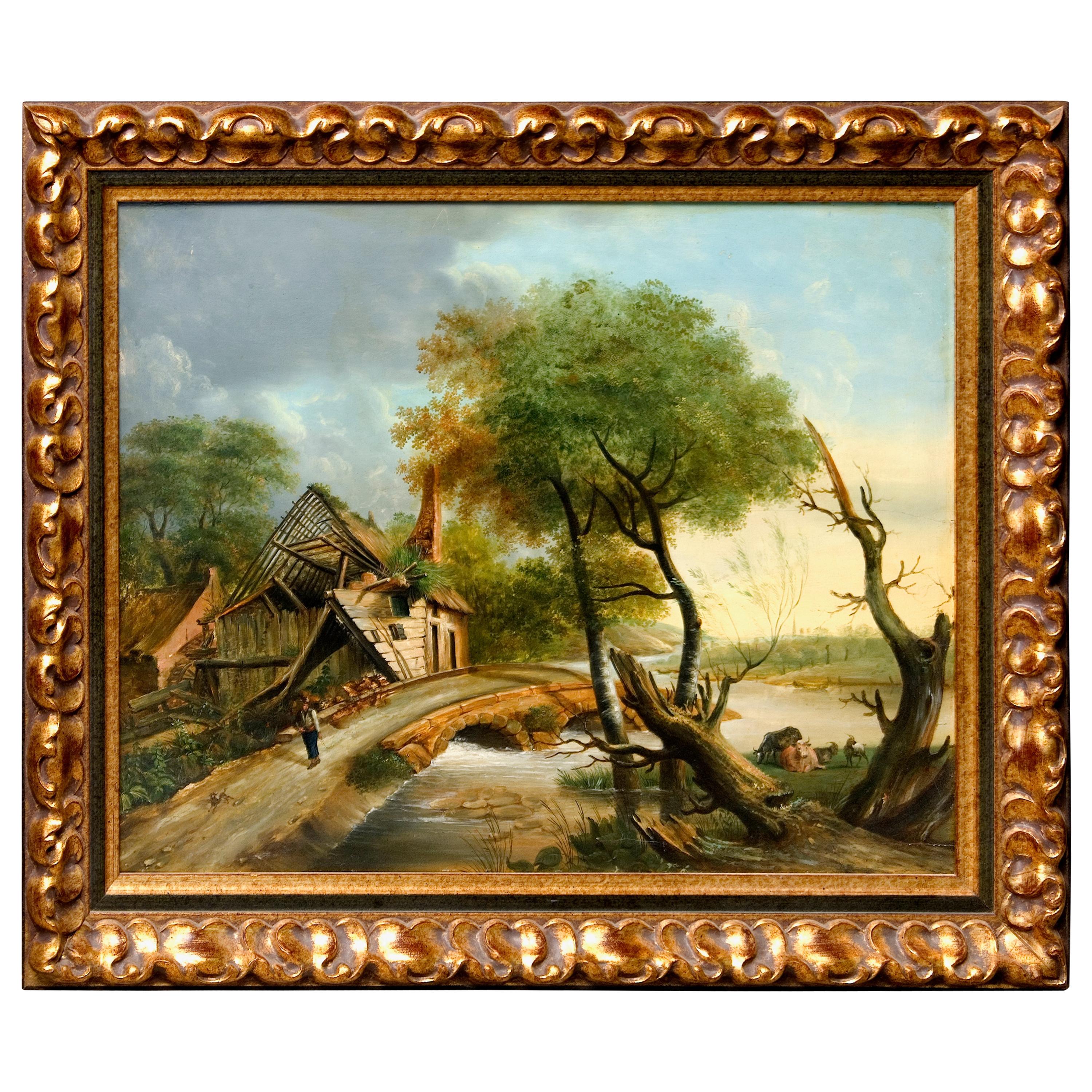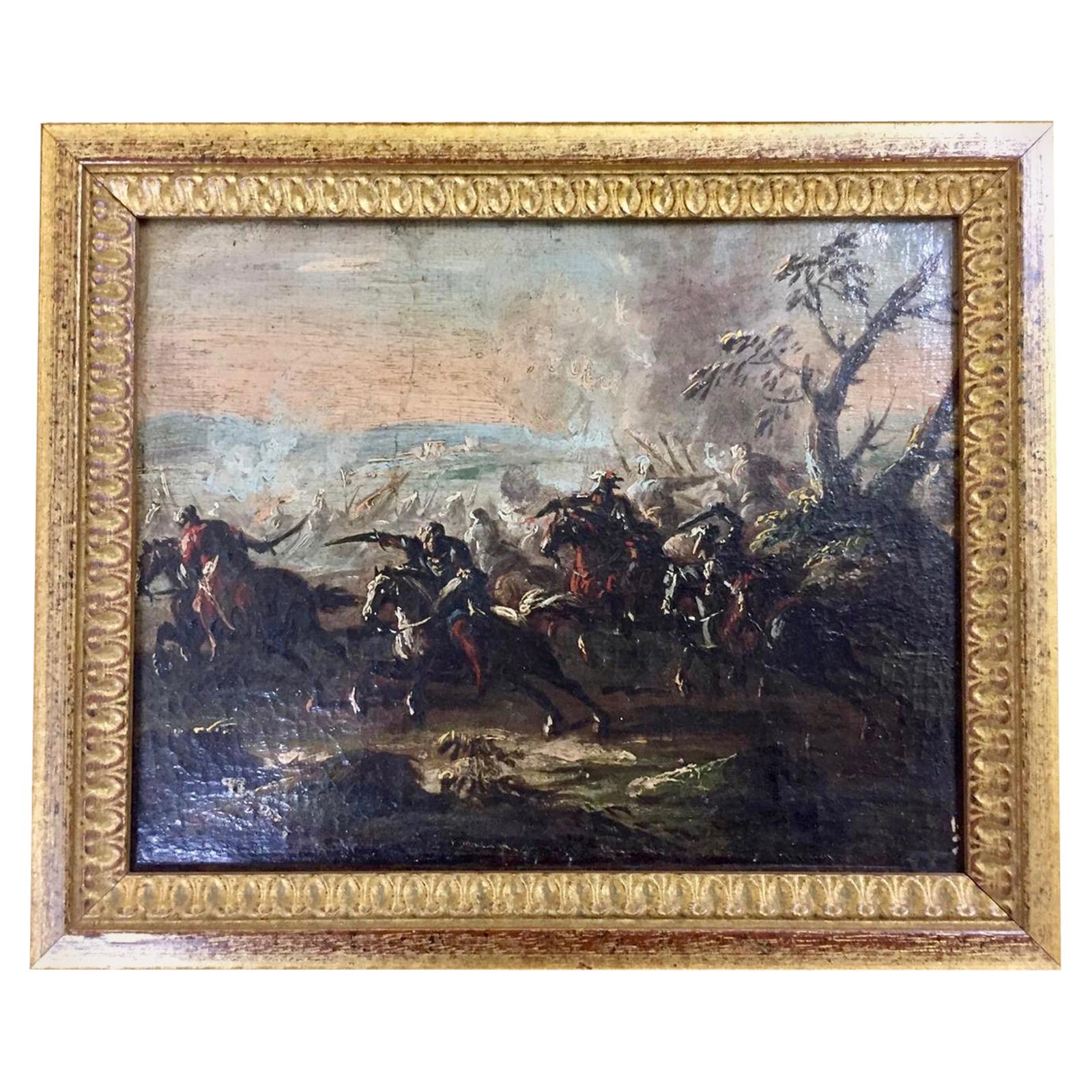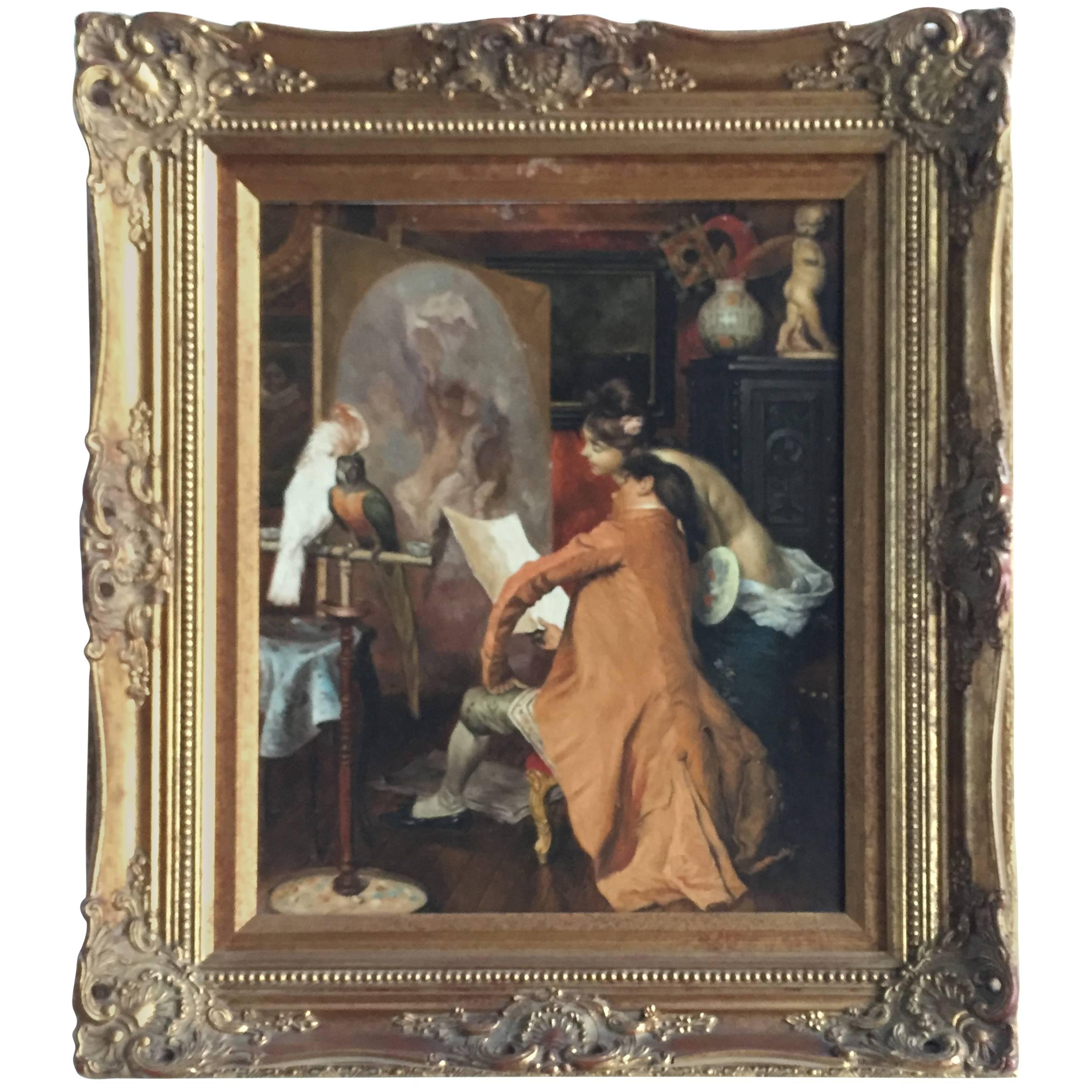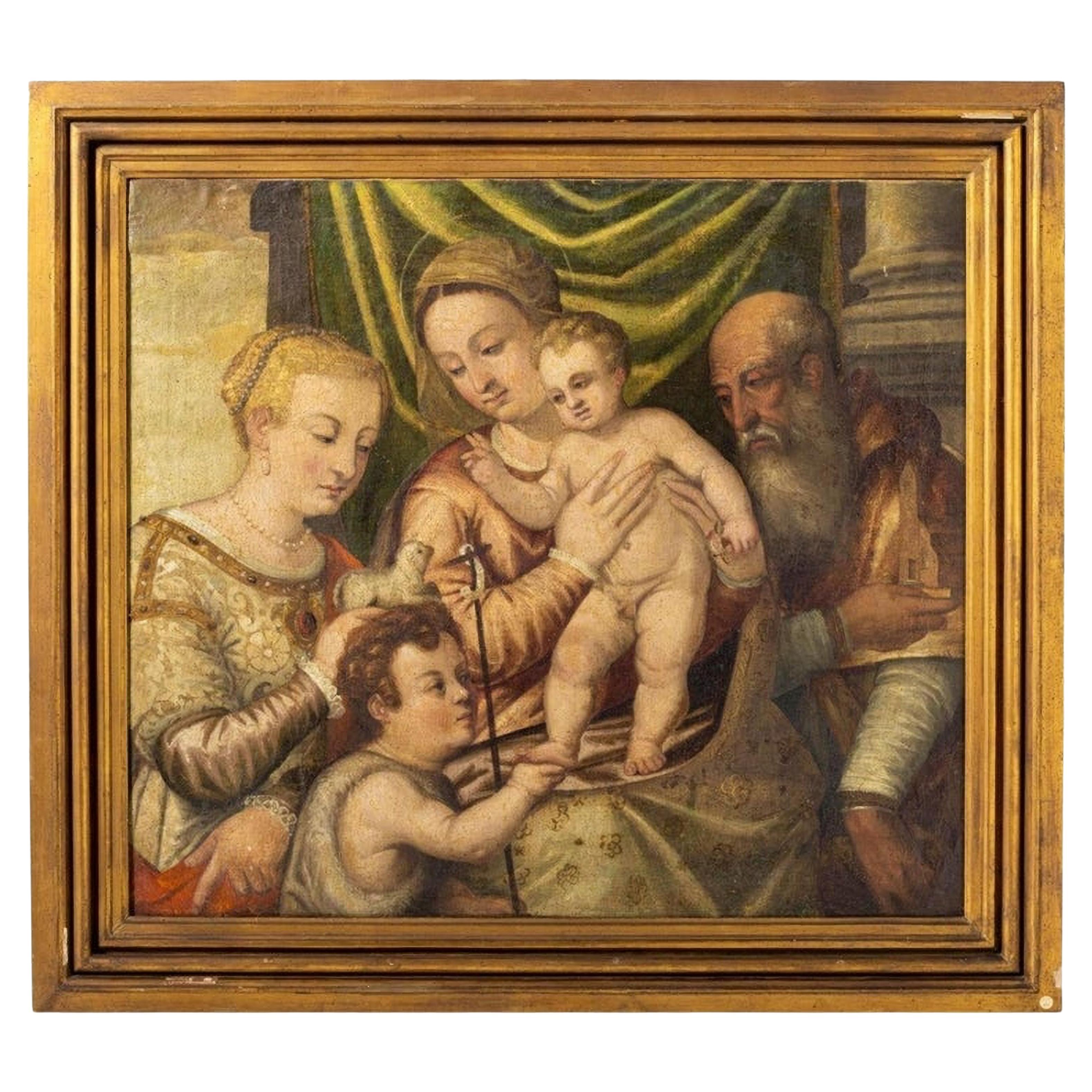Items Similar to Antonio Travi Called Le Sestri, Seascape with Ruins, Genoa 17th Century
Want more images or videos?
Request additional images or videos from the seller
1 of 7
Antonio Travi Called Le Sestri, Seascape with Ruins, Genoa 17th Century
About the Item
Antonio Travi called Le Sestri (Sestri Ponente, 1608 - Genova 1665)
Seascape with ruins
Genova, First half of 17th century
Oil on canvas with his original 17th century frame
Measures: 170 x 200 cm
This painting has been studied by Professor Ugo Ruggeri who proposed the attribution to Antonio Travi. The expertise is available for the potential buyer.
Antonio Travi is the first true painter of the Ligurian coastal landscape.
While still in his teens, around 1625, Travi spent time in the workshop of Bernardo Strozzi (1581/1582-1644), as one can see from his long, richly-loaded brushwork technique.
Very soon thereafter, Le Sestri created his own language, which included backgrounds with ruined buildings and narrative scenes with colorful small-scale figures. Travi’s animated scenes follow the narrative tradition of Filippo Napoletano (circa 1590-1629) or those of his contemporary Salvatore Rosa (1615-1673). Genoa and the Ligurian coastline provided abundant material for maritime subjects, and the artist filled his foregrounds with fishing scenes, small boats and towing.
Antonio Travi offers us an original blending of Genoese and Northern European traditions, and in particular a response to the art of Goffredo Wals (1595?-1638?), whose presence in Genoa is recorded from November 1623 onwards, and whose treatment of cool, precise light is shared by our artist.
This large canvas depicting a seascape with ruins presumably decorated an aristocratic Genoese palace, as suggest by the monumental dimensions of the canvas accompanied by its original frame.
This beautiful landscape with architectural ruins, fully reflects the pictorial poetics of Antonio Travi that remains constant throughout his career: the highly realistic description in this painting, with its shoreline covered in bright shingle and a crystalline light that precisely defines the reliefs and ruins in the background, lends the whole composition a modern tonality.
Looking at the style characters, we see the proof of the brush stroke and the love for the typical color of the master Strozzi, but also a clarity and precision typical of the Flemings active in Genoa, with a reference particular to the German Goffredo Wals, present in several collections of the Genoese aristocracy.
The luminous and metaphysical scenes of Wals are translated into Travi's painting with a ruinist taste in Ligurian key, through rapid brush strokes, a dense color and a fantastic naturalism accentuated by a silvery luminosity.
From the proposed canvas, we can deduce typical elements of his palette, such as precise chromatic chords and the studied insertion of lighter shades on the basic tones of the lands and whites.
His works are always animated by little figures who carry out their daily activities with simplicity: they bring their flock to drink or to graze on the banks of the river. However, it must be emphasized that the presence of the man does not seems never to be decisive, but that the true protagonist of his works is a nature that reveals itself in all its simplicity. This painting makes it explicit: almost a manifesto of its poetic vein, where ruin is the real queen of the stage.
The link with other autograph works by the artist is evident, notably the "seascape with ruins" from the Zerbone collection in Genoa or the "Rebecca at the well" still preserved in a private Genoese collection.
Bibliography :
• Genova nell’età Barocca, catalogo della mostra, a cura di E. Gavazza e G. Rotondi Terminiello, Genova Galleria Nazionale di Palazzo Spinola 1992, N. 167-168
• E. Gavazza, F. Lamera, L. Magnani, La pittura in Liguria. Il secondo Seicento, Genova 1990, n. 52-54
• Pietro Torriti , "La natura morta e il paesaggio", dans La Pittura a Genova e in Liguria dal Seicento al primo Novecento, Gênes, 1987
• Gianluca Zanelli, Antonio Travi e la pittura di paesaggio a Genova nel'600, Gênes, 2001.
- Dimensions:Height: 67.33 in (171 cm)Width: 78.75 in (200 cm)Depth: 3.94 in (10 cm)
- Style:Baroque (Of the Period)
- Materials and Techniques:
- Place of Origin:
- Period:
- Date of Manufacture:17th Century
- Condition:Wear consistent with age and use.
- Seller Location:Bruxelles, BE
- Reference Number:1stDibs: LU6666233677842
About the Seller
5.0
Vetted Seller
These experienced sellers undergo a comprehensive evaluation by our team of in-house experts.
1stDibs seller since 2022
6 sales on 1stDibs
Typical response time: <1 hour
- ShippingRetrieving quote...Ships From: Bruxelles, Belgium
- Return PolicyA return for this item may be initiated within 3 days of delivery.
More From This SellerView All
- Leandro Bassano - 17th century - Portrait of a SavantBy BassanoLocated in Bruxelles, BELeandro Bassano (Bassano del Grappa 1557 - Venise 1662) Portrait of a savant Venise, XVI century Oil on canvas; modern frame. Measures: 117 x 88 ...Category
Antique 17th Century Italian Renaissance Paintings
MaterialsCanvas
- A Captive Soldier - Italie (Rome), 17th centuryLocated in Bruxelles, BEA Captive Soldier Gilt Bronze, Lost Wax Italie (Rome), 17th century H 17 x Dia 10 cm H 6 2/3 x Dia 4 inch The 17th century witnessed a flourishing of artistic expression across Eur...Category
Antique 17th Century Italian Baroque Figurative Sculptures
MaterialsBronze
- Cerberus, Italy, 17th CenturyLocated in Bruxelles, BECerberus Black painted stone Italy, 17th century Measures: 80 x 69 x 36cm (one head missing) Cerberus, cruel monster, fierce and strange, Through his wide threefold throat barks as a dog Over the multitude immers'd beneath. His eyes glare crimson, black his unctuous beard, His belly large, and claw'd the hands, with which He tears the spirits, flays them, and their limbs Piecemeal disparts (Dante, Inferno, Canto VI). Cerberus figure seated, in his role of ferocious guardian of the underworld; he shows a nervous musculature, an adherent skin which reveals the ribs, long and robust limbs; his heads are broad and the eyes set well apart. Painted in black to amplify his menacing look, the infernal guardian is depicted with his famous attributes, writhing his heads, growling and barking furiously. Cerberus, in Greek mythology, was the monstrous watchdog of the underworld – also known as the “hound of Hades” – preventing the dead from leaving, and making sure that those who entered never left. A child of Typhon and Echidna, he was part of a monstrous family, which included Orthus, the Lernaean Hydra, and the Chimaera as well. Only on three occasions Cerberus was tricked by visitors of Hades: Heracles did it with his strength, Orpheus with his music. In "The Inferno", Dante places Cerberus as the guardian of the third circle of Hell. With his three mouths, Dante saw Cerberus as a beast that was synonymous with the sin of Gluttony. Virgil gets past the monster by throwing mud in his three mouths, temporarily choking him. Very rare are the representations of Cerberus in ancient statuary...Category
Antique 17th Century Italian Renaissance Figurative Sculptures
MaterialsStone
- 17th century - plateau with two breasts, attribute of Saint AgathaLocated in Bruxelles, BEPlateau with two breasts, attribute of Saint Agatha Southern Italy, 17th century Polychrome and gilded wood 20 x 14,5 x 15 cm Born into a noble lineage, Agatha came into the world ...Category
Antique 17th Century Italian Baroque Figurative Sculptures
MaterialsWood
- Marble Lion, Périgord, 17th CenturyLocated in Bruxelles, BEMarble lion white marble France, probably Périgord, 17th century Small marble lion wearing a coat of arms pendant with the engraved date, ...Category
Antique 17th Century French Renaissance Animal Sculptures
MaterialsMarble
- Large Terracotta Relief - Lombardy, First Half of 17th CenturyLocated in Bruxelles, BELarge Terracotta relief of the flight into Egypt Lombardy, first half of 17th century Painted terracotta 91 x 85 x 11,5 cm This event in the early life of Christ is recounted i...Category
Antique 17th Century Italian Baroque Figurative Sculptures
MaterialsTerracotta
You May Also Like
- Northeuropean Landscape with Ruins, 17th Century Style, Early 20th CenturyLocated in Madrid, ESOil on board. Rural landscape with a watercourse, a stone bridge and a house in ruins, located among trees, animated by the presence of a person and without apparent subject matter ...Category
Early 20th Century European Baroque Paintings
MaterialsWood
- Pair of Italian 17th Century Oil on Canvas Paintings by Antonio TraviLocated in West Palm Beach, FLA stunning pair of Italian 17th century oil on canvas paintings by Antonio Travi. Each painting displays an impressive array of rich colors, typical of T...Category
Antique 17th Century Italian Paintings
MaterialsCanvas, Giltwood
- Francesco Graziani, Called Ciccio Napoletano, 17th CenturyBy Francesco GrazianiLocated in CHFrancesco Graziani, Called Ciccio Napoletano, 17th Century He was active in Naples and Rome around the second half of the 17th Century.Category
Antique Late 17th Century Italian Baroque Paintings
MaterialsCanvas
- 17th Century PaintingLocated in Miami, FL17th century painting J.Castano 17th century SpainCategory
Antique 17th Century Baroque Paintings
MaterialsCanvas
- Still life with musical instruments 17th centuryLocated in Badia Polesine, ROStill Life with Musical Instruments Epoch: late 1600s Origin: Milan Size: 138x100 cm with frame, 130x90 cm canvas only. Description: Magnificent still life with musical instruments d...Category
Antique Late 17th Century Italian Baroque Paintings
MaterialsCanvas
- Flemish School 17th CenturyBy Europa AntiquesLocated in Madrid, ESFlemish school 17th century "Our Lady with the Child Jesus, St. John, St. Elizabeth and Zacarias". Oil on canvas Relined. Dimensions: 74 x 84 cm good conditions.Category
Antique 17th Century Dutch Baroque Paintings
MaterialsPaint
Recently Viewed
View AllMore Ways To Browse
17th Century Keys
17th Century Reliefs
Antique German Scale
Aristocracy Painting
Antique Still Banks
Still Building Banks
Oil Paintings Art Drinking Scenes
Pietro Man
Italian Coastline Painting
La Rosa Italian
Antique Oil Lighter
Baroque Drinks
Seascape 17th
Antique German Lighter
Paintings Canvas Travis
Antonio Dal
Italian Painting Liguria
Oil Painting Liguria





